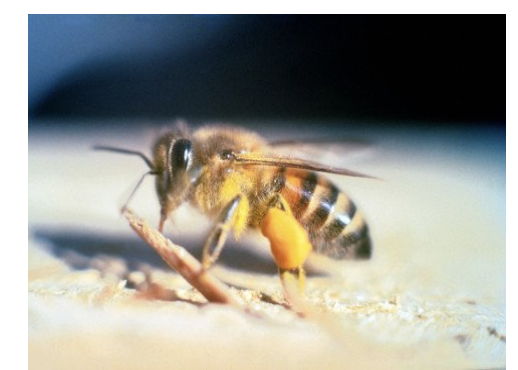Credit:Biovision:Infonet
Honey Bees in Kenya
There are many different species of bees in the world most of them solitary (living alone). A few species of bees are kept for pollination and honey production. In Kenya the most important species is called the honeybee or Apis mellifera. This is the species of bee that is familiar to everyone. It is this species of bee that this book is about. Within this species there are a number of races of bees in Kenya which have their own particular characteristics. We have Apis mellifera scutellata, Apis mellifera monticola, Apis mellifera yeminitica (nubica) and Apis mellifera littorea.
Apis mellifera yemenitica (formally A. m. nubica)
This is the smallest race in Africa. It has the most slender abdomen and the largest yellow abdominal colour band of all African races. It commonly withstands and survives drought conditions by frequent migration. It is mostly found in the northern parts of Kenya.
Apis mellifera scutellata

(c) Jeffrey W. Lotz, www.insectimages.com
Apis mellifera littorea
This bee inhabits the low lands of the Kenya Coast. It does not migrate as much as scutellata. It has a tendency to rear brood throughout the year due to availability of forage along the coast.
Apis mellifers monticola
This bee is called the mountain bee and is found at high altitudes in Tanzania and Kenya – 1,500 – 3,100 meters. The bee inhabits places where the sun is frequently obscured by clouds and mist and ground frosts can occur at night. It is the largest bee in Africa. It has a tendency to reduce brood rearing at the first sign of forage decline and may not migrate. It is less productive and less vicious. It is found in Meru and Mt. Elgon. (Source National Beekeeping Station, Nairobi).
Honeybees from other countries in Africa
Apis mellifera intermissa
This is a North African race of honeybee found north of the Sahara from Libya to Morocco. The bee is reputedly very aggressive and swarms frequently. During droughts over 80% of colonies may die but owing to intensive swarming colony numbers increase when conditions improve.
Apis mellifera lamarckii
Egyptian bees found in North East Africa primarily in Egypt and the Sudan along the Nile Valley. Like intermissa they rear numerous queens with one colony recorded as rearing 368 queen cells and producing one small swarm with 30 queens!
Apis mellifera adansonii
These bees are found in West Africa and are yellow in colour. They appear to be very similar to scutellata in many of their behaviours.
Apis mellifera capensis
These bees are found in South Africa and are unique among Apis mellifera in that they have a common occurance of female-producing laying workers.Some of these races are highly aggressive if the nest is disturbed, but stay calm if there is no brood or stored honey to protect. The African bees are also more likely to abscond (abandon) their hives on slight disturbances, and in some areas the colonies migrate seasonally.
Stingless Honeybees
There are also species of stingless bees in Kenya. These bees also produce honey which is prized as a medicine. Stingless bees can be kept in small hives but are not kept commercially in Kenya at the moment. However there has been renewed interest in these bees recently with the discovery of new species in Kakamega by a scientist working for the National Museums of Kenya.
Note: This article on African races of bees and their behaviour will be developed over time to include more detailed information on specific African bee races. An understanding of the type of bees we have in Africa and their behaviour is fundamental to good beekeeping.